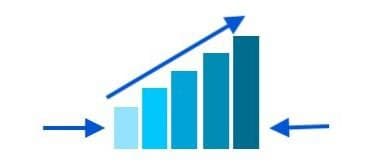How to Solve the Skyscraper Puzzle ?
While playing the game, you need to imagine that you are looking at an aerial view of a city block made up of skyscrapers of different heights. The number in a cell indicates the height of the skyscraper in that cell. (For example, the number 4 represents a 4-story building). A number outside the grid defines how many skyscrapers can be seen in that row or column from the perspective of that number.
In real life, we can't see the buildings behind a tall one in front of us. However, if there is a low-rise building in front of a high-rise one, we can see both. You need to keep this information in mind when placing the numbers. That is, the number 1 on the edges means that only one building can be seen from that angle, and the number 2 means that only two buildings can be seen. To fully understand what we mean, please examine the image below.

In fact, there are no other rules in the game. There may just be some hints. In the skyscraper game, the locations of tall buildings are generally determined first while solving the puzzles. Noting the possibilities inside the squares will make your job easier in the skyscraper game, as in many similar types of puzzles. To better understand the subject, let's solve an example question.
How to Play ?
To demonstrate how to play, we will solve the example below. The puzzle consists of a 4×4 grid, so the numbers you'll use range from 1 to 4. It is advisable to start with the largest number, which in this case is 4. This clue indicates that you can see all four buildings from that perspective. Therefore, the tallest building should be placed at the back, making the sequence 1, 2, 3, 4.

In the column at the top labeled as the second column, the hint is 1. There's only one possibility here because the hint of 1 on the top side indicates that only one skyscraper can be seen from that angle. Similarly, the number 1 located in the first column from the bottom indicates that only one skyscraper can be seen from below. The same situation applies to the third row from the right side.

Since each number can only be used once in each row and column, the only place where the number 4 can appear in the second row is the third column. On the right side, the hint number in the fourth row is 2, meaning that only two skyscrapers can be seen from that angle. Since there is already a 1-story building in the first column of that row, only a 3-story building should be placed in the far-right column so that only two skyscrapers can be seen.

In the first row, the number 3 cannot be placed in the first column, nor can it be placed in the far-right column, as two of the same numbers cannot be in the same column. The only place where 3 can be is the third column of the first row. From the bottom in the third column, in order to see three skyscrapers, the remaining spaces must be filled with 1 and 2. In this case, the only number that can go into the second column of the bottom row is 2.

From the bottom, the hint number in the second column is 3, and already two can be seen. When we try to place the number 3 in the third row, second column, and the number 1 in the second row, second column, the only number that can go into the remaining space in the first column of the third row is 1. In the first row, the only place where the number 1 can go is the fourth column. The remaining space in the first column of the first row then gets filled with the number 2.

Only two empty cells remain. By placing the number 3 in the first column of the second row and the number 2 in the fourth column of the second row, we complete the arrangement of the skyscrapers.
